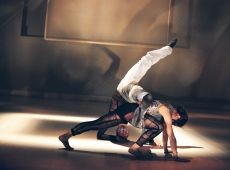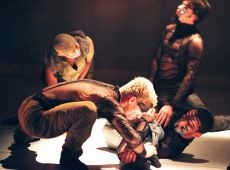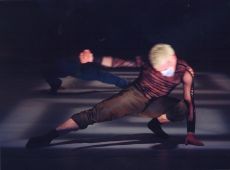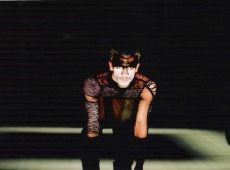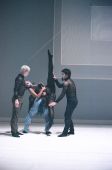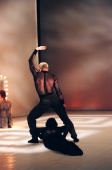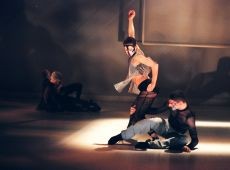overview
* In reality, the circumstances of Raymond Roussel's death have never been completely brought to light.
press
Les Saisons de la Danse
Intelligent tendency..."The greatest magnetiser of modern times wrote André Breton of Raymond Roussel. It is understandable that Lionel Hoche, a man of an inquisitive nature, should fall under the charm of the French writer admired by surrealists and thought of as a pioneer. But you don't need to know the latter's literary oeuvre in order to appreciate the latest work from the Saint-Etienne based choreographer, entitled Enroussellements. A piece made up of the ingredients found in the choreographer's later work, with special attention paid to a very graphic and plastic set-design, created around the idea of transparency and geometrical shapes and conceived by Lionel Hoche himself. The same care is taken with the lighting concocted by Mikki Kunttu, working for the first time with the company. The overall result might be considered mannered but remains coherent thanks to body movements which are clearly not. The movement is full and de-structured, skilful and beautiful. There is poetry and humour, black (the costumes are on the dark side) and white (the geometric shapes on stage), bodies dancing and vibrating. The same intelligence is found in the sound track, an explosive mix of French touch techno, pseudo-waltz and melancholy classical music (Darius Milhaud)... a beautiful show with wonderful performers and a remarkable quality of movement."
Gallia Valette-Pilenko, April 2000
Agenda Stéphanois
Enroussellements... "Lionel Hoche who, need we recall, is currently resident at the Esplanade, is a choreographer who inspires us to say :‘roll on the next show'... No format, no gauge here, only creativity, originality, rhythm, freedom and the dancers' grace.
...What more to say without making Hoche's modest appearances during the applause difficult, except one regret, that the show be programmed for such a short run. Three performances are clearly better than one, but one or two more would have given others the chance to discover that there is talent in Saint-Etienne."
1st March 2000
European Dance News
· The triptych of Saint-Etienne..."This is passionate work, full of all kinds of ideas and of playful, pleasant, beautiful, ingenious and dynamic finds."
Michel Odin, European Dance News, March 2000
Culture Loire
Hochellements... "A show which leaves the spectator complete freedom, even that not to have read Roussel, the choreographer's inspiration.... The company MéMé BaNjO gave me a hospitable show, one in which I could feel at home, choosing the verses of its poetry which told me what I wanted to hear. Funny too. All carried along on over a joyful soundtrack mixing African melodies, techno rhythms, a crazy waltz and a grand finale with Milhaud's The Creation of the World."
Dominique Bardel, 23rd February 2000
René Sirvin, Le Figaro
Masked abstraction... "In a radiant décor of light-weight white canvases, six dancers capture our attention...
The composition of "Enroussellements" is full of the choreographer's usual twists and turns, the supple performers, turning and sliding in their socks, more often sitting or laying down than standing up. The skilful trio of Joke Martin, Guillaume Cuvilliez and David Drouard is particularly noteworthy, playing with their bowler hats... ; followed by a strange surrealist tableau where two dancers (Leïla Pasquier and Angélique Willkie) hold huge deforming magnifying glasses in front of their faces, making their heads horrifically enormous. Added admiration for a double duo of dancers totally entangled on the floor..."
René Sirvin, 12th February 2000
La Tribune Le Progrès
Abracadabra !... "Echoing the wild creativity of Roussel, Lionel Hoche makes humorous and poetical allusions () in this trilog, throwing the gates of his imagination wide open.
First building then deconstructing the choreography, Lionel Hoche masters chaos, his ingenious set-design highlighting the dance's progression through geometrical forms reflected in detachable panels. Art interwoven in art, multiple cycles in a single cycle..."
Claudie Léger, 11th February 2000
Libération
The metamorphosis of Lionel Hoche..."Despite appearances, the choreographer Lionel Hoche, based in Saint-Etienne, is undoubtedly one of France's most sought-after choreographers by reputed international ballet companies (a journey that has taken him from the Nederlands Dans Theater to the Monte-Carlo Ballets, via the Lyon Opera Ballet). His career has been prolific, all the richer for his years at the Paris Opera Ballet School, his time as a performer with Jiri Kylian's company, and his contemporary experience with Daniel Larrieu..."
Stéphane Lebard, 10th February 2000
La Montagne
Lionel Hoche knows his classics and knows how to play with words... "A kaleidoscopic choreography whose rhymes, obsessions and fascinations reinvent Roussel so well, without ever plagiarising him. So well that we let ourselves be lulled into this strange dream without aim or apparent design (or so it would seem!) yet so full of elusive images, visions, and trompe-l'oeil that we happily go along with it. With delicious complicity, knowing madness. These "Enroussellements" fit and merge together in learned bewitchment."
R.D., 26th January 2000
